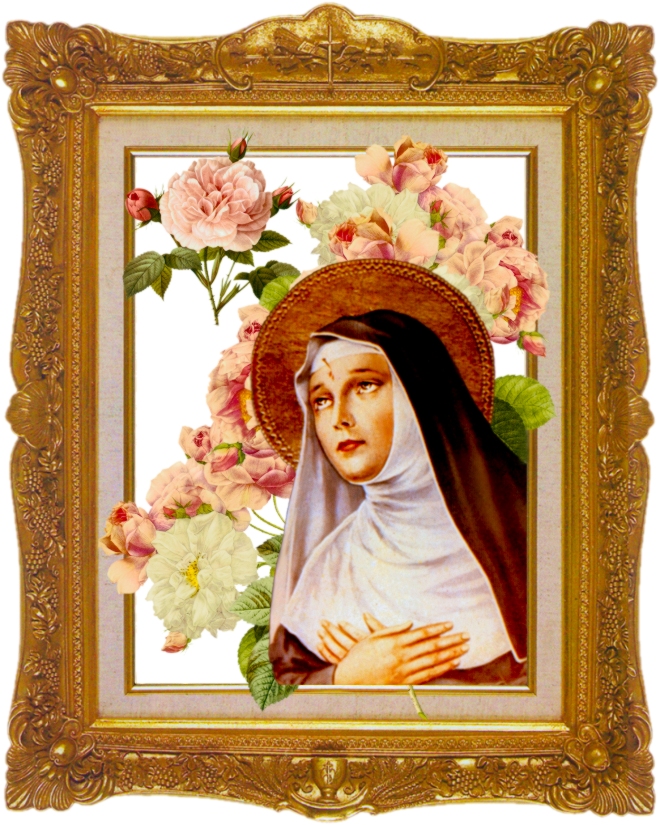

Rocco Porenna is small village three miles outside of Cascia, situated on a small river, in a valley separated from the adjoining mountains by a cliff, so that the place looks like a perfectly formed pine cone. There is a tradition that at the time of Our Lord's death on the hill of Calvary, an earthquake split the rocks of the mountains near Cascia, and that this particular cliff remained detached from the mountain. on account of its rocky site, Porenna is called Rocco Porenna.
In this village in 1309, there lived a devout couple, Antonio Mancini and Amata Ferri, who were prosperous farmers, although not rich and who gave generously to the poor and lived a humble life all for God. They were, in fact God's very apostles to Rocco Porrena because they taught their neighbors by word and example the only way to save their souls, was by fearing and loving God, as well as by shunning sin and vice. The complete story of the apostolic work of St. Rita's parents is known to God alone. nevertheless, one of its chapters has been handed down by a chronicler of the Augustinian Order:
St. Rita's parents had a home dedicated to prayer, a sanctuary of holiness with perfect conformity to the commandments of God and the Church. They meditated morning and night on the Passion of Jesus Christ; both had a great devotion to the Virgin Mary as Mary Immaculate.
For miles around they were known for the benevolence to those in need and for their radiant smiles. through their prudent and gentle influence family dissensions were healed and indifferent souls won back to the friendship of God.
They had a zeal for saving souls. Whenever an occasion required it, they would look for a way to approach the sinner without embarrassing of offending him, reproving with kindness, continuing until even the most hardened sinners were moved to repent.
Living amidst this holy peace and happiness, there was one joy lacking, that of a child, although they had prayer fervently, even when they had become advanced in years. God bestowed at last the same Divine favor He gave to Anna and Joachim, a child late in life:
One night, while Amata was praying, an angel appeared to her in a vision, and told her that it was the Will of God that there would be born of her a daughter who would be from her very birth, marked with the seal of sanctity, gifted with every virtue, and that she was to be a helper of the helpless, an advocate of the afflicted, and a guiding star in the firmament of the Church.
The biographers of St. Rita give the day and year of her birth as Saturday, May 22, 1381. Pope Urban VI was the reigning Pontiff.
St. Rita died on a Saturday, May 22, which is a day dedicated to our Blessed Mother, as a number of other saints have died on a Feast of Our Lady or on a Saturday in May, not coincidentally. The village considered the birth a miracle because of Amata's age.
A few days after the birth, the Baptism of their child was in the offing and both parents were deciding on a name. Antonio wanted the name to be Rita because that was the name given in Amata's vision, so she was Baptized on her fourth day in St. Mary's church in Cascia as Rocco Porenna had no Baptismal font. At the time Rita was not a known name for a saint, but since that time the sweet name of Rita has been given to many Catholic baby girls. Some say that Rita is a shot name for Margarita but, the Saint was not Baptized Margarita but Rita, so we know it was not a contraction. Shortly after the Baptism God attested, by a singular prodigy, that her name was not of human invention, but rather of Heavenly origin:
The day after her Baptism, the fifth after her birth, a swarm of bees, white as the driven snow, was noticed hovering and buzzing around the sweet angelic face of baby Rita, as she lay quietly sleeping in her cradle. The bees alighted on her lips and were seen to enter and issue from her partially opened mouth, without harming her or causing her to awaken. All who witnessed this prodigy recognized that it implied a mystery, although they could not fathom it. In after years Rita herself made known the meaning of the mystery by the singular sweetness and simplicity of her manner and by the eminent sanctity of her life; the bees were also a presage of her Beatification by Pope Urban VIII.
After all these centuries, the swarm of bees still exists in the convent, within a small fissure in a wall midway between St. Rita's cell and the place of her sepulcher. Their color is not white, but that of the common bee, except they have no sting. They live retired during the year, only coming out in the last few days of Holy Week and then returning once again for the Feast of St. Rita. On one occasion, one of the bees was given to Pope Urban VIII but it would not remain and went back to the convent.
HOME--------------PRAYER
INDEX
www.catholictradition.org/Cascia/rita1-2.htm

